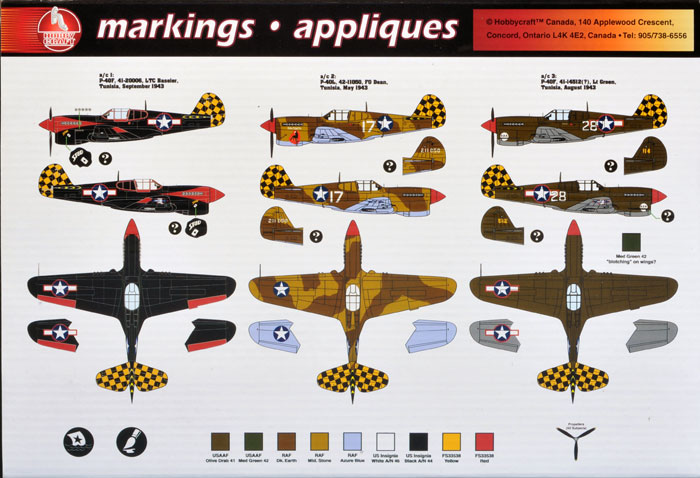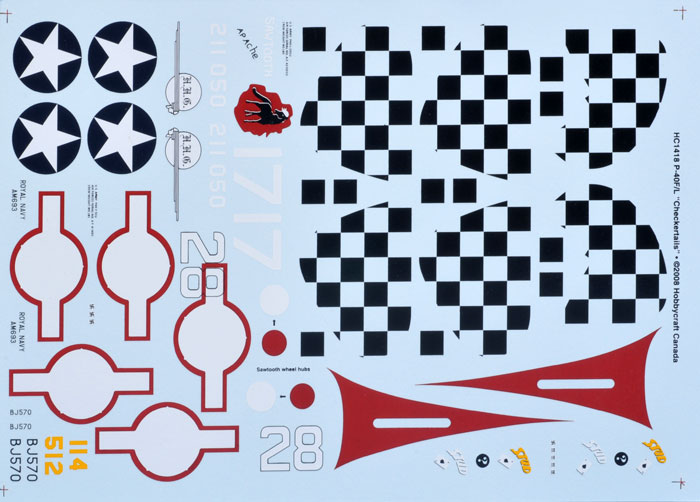|
Curtiss P-40F / L
Checkertails

Hobbycraft, 1/48 scale
S u m m a r y
|
|
Catalogue Number: |
Hobbycraft No. HC1418 -
Curtiss P-40F / L Checkertails |
|
Scale: |
1/48 |
| Contents and
Media: |
around 65
parts in grey plastic; seven clear plastic parts; markings for
three aircraft. |
| Price: |
USD$25.20 available online from Squadron and
from hobby retailers worldwide
|
| Review Type: |
FirstLook |
| Advantages: |
Accurate outline; reasonable level of detail; the only moulds for these variants in 1/48 scale; useful options
with all parts needed for either P-40F and L variants;
high
quality clear parts; excellent marking options. |
| Disadvantages: |
Some mould
deterioration evident on rear fuselage; small details
missing (see text). |
|
Conclusion: |
Quite nicely detailed and easy to build, this is the only game in town for a Merlin powered P-40s. |
Reviewed by Brett Green

Hobbycraft's 1/48 scale P-40F/L is available online from Squadron.com
The P-40F and L variants were powered by the Rolls Royce Merlin engine. Although the combination of this iconic British engine with an American airframe worked fabulously for the P-51B, C and D Mustang, the results were not as dramatic for the Kittyhawk due to the overall heavier weight of these variants.
The installation of the Merlin engine required a redesign of the nose area. The overall shape of the forward fuselage and large cooler housing under the nose was revised, and the air intake on top of the cowling was deleted.
Hobbycraft has now released a 1/48 scale P-40F/L. If this kit looks a little familiar, it is because the sprues have previously been
available in other guises.
The initial release for this family was a P-40N and several other variants
from AMT in the early 1990s, followed by AMtech's P-40E, F, L
and K kits based on the same family of moulds between 2002 and 2005.
However, we have not seen the P-40F and L kits in some time, and these are the only 1/48 scale moulds for these Merlin-powered variants.
Hobbycraft's 1/48 scale P-40F/L comprises around 65 parts
in medium grey styrene and seven parts in clear. Panel lines are crisply
recessed, complimented by restrained lines of rivets here and there.
Detail in the cockpit is adequate. Wheel wells are boxed in on three
sides, but the main undercarriage legs are a little simplified.
Supplied stores include two 500lb bombs and a centreline
drop tank.
Some smaller details are missing. These include the ring and bead
gunsight, mirror, whip antennas, fuselage spine navigation light, fuel
dump, fresh air intakes and landing gear indicators. The canopy rails
have also been omitted. All of these items can fairly easily be added
from scrap plastic and other materials commonly found in the modelling
toolbox.
The wheels are the larger variety appropriate for these variants.
The overall shape and contours are good, but the spinner comes to a
perfectly sharp point. The overall profile of the aircraft looks better
when this part is slightly rounded-off.
The wings feature the correct shape and the appropriate wash out at the tips.
The moulds have held up quite well over the years, but there is some
slight distortion of the plastic on the rear fuselage. It is not
terrible, but some modellers may want to smooth and rescribe this area.
The clear parts are impressively thin and free of
distortion.
The sliding section of the canopy will ride high when in the "open" position
on both variants.
A vacform replacement will address this problem.
Kit engineering is quite conventional. I have built a few of the AMtech
variants of this kit and the only troublesome area is the fit of the
engine cowling panels. I recommend that these panels should be glued in
place before the fuselage halves are joined. Last time, I "tacked" the
panels in place with super glue, then made the bond permanent with
liquid glue. There may also be a gap at the wing root join. Check the
fit before gluing the wing to the fuselage and, if necessary, a spreader
bar can be installed to widen the fuselage.

Three attractive "Checkertail" marking options are offered. A full colour marking guide is provided on the back of the box.

Decals are well printed and in perfect register with thin carrier film. Colours look good.
I have a bit of a soft spot for these AMT-sourced P-40s.
They are easy to build (arguably easier than Hasegawa's), with
relatively few fit problems. The only
inserts are the cowl panels and these fall on natural panel lines.
The big advantage of this kit though is that nobody else has kitted the P-40F or L in 1/48 scale.
Some good, inexpensive accessories are available for this kit too.
The True Details cockpit is one that comes to mind. I used this
inexpensive yet very effective resin cockpit when I last built the AMT
P-40N (pictured below) in 2004.

If you want to build one of the Merlin-powered Kittyhawks / Warhawks, Hobbycraft's offering is your best bet straight from the box.
Thanks to Hobbycraft for the review sample.
Review Text and
Images Copyright © 2009 by Brett Green
Page Created 27 February, 2009
Last updated
27 February, 2009
Back to HyperScale Main Page
Back to Reviews Page
|
